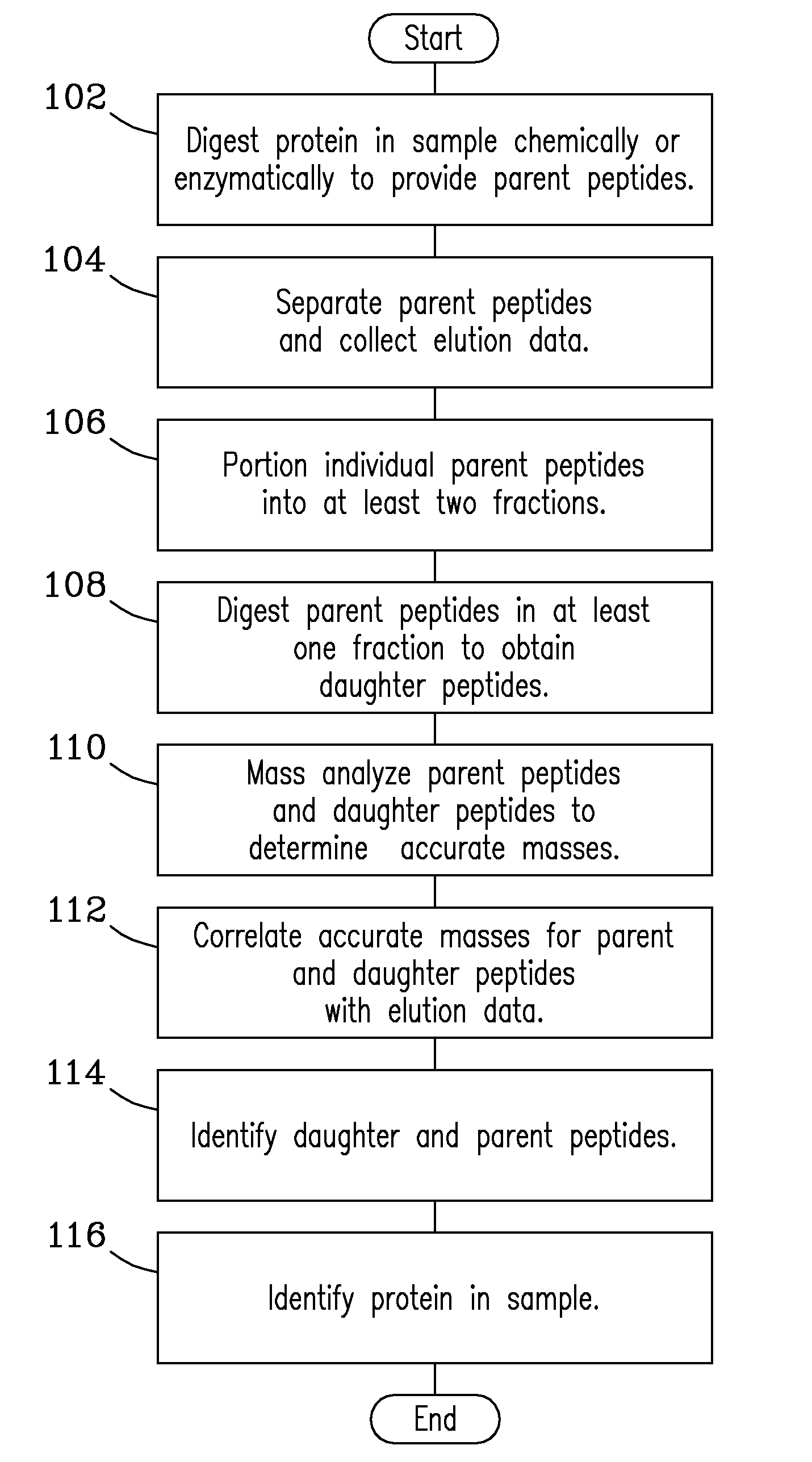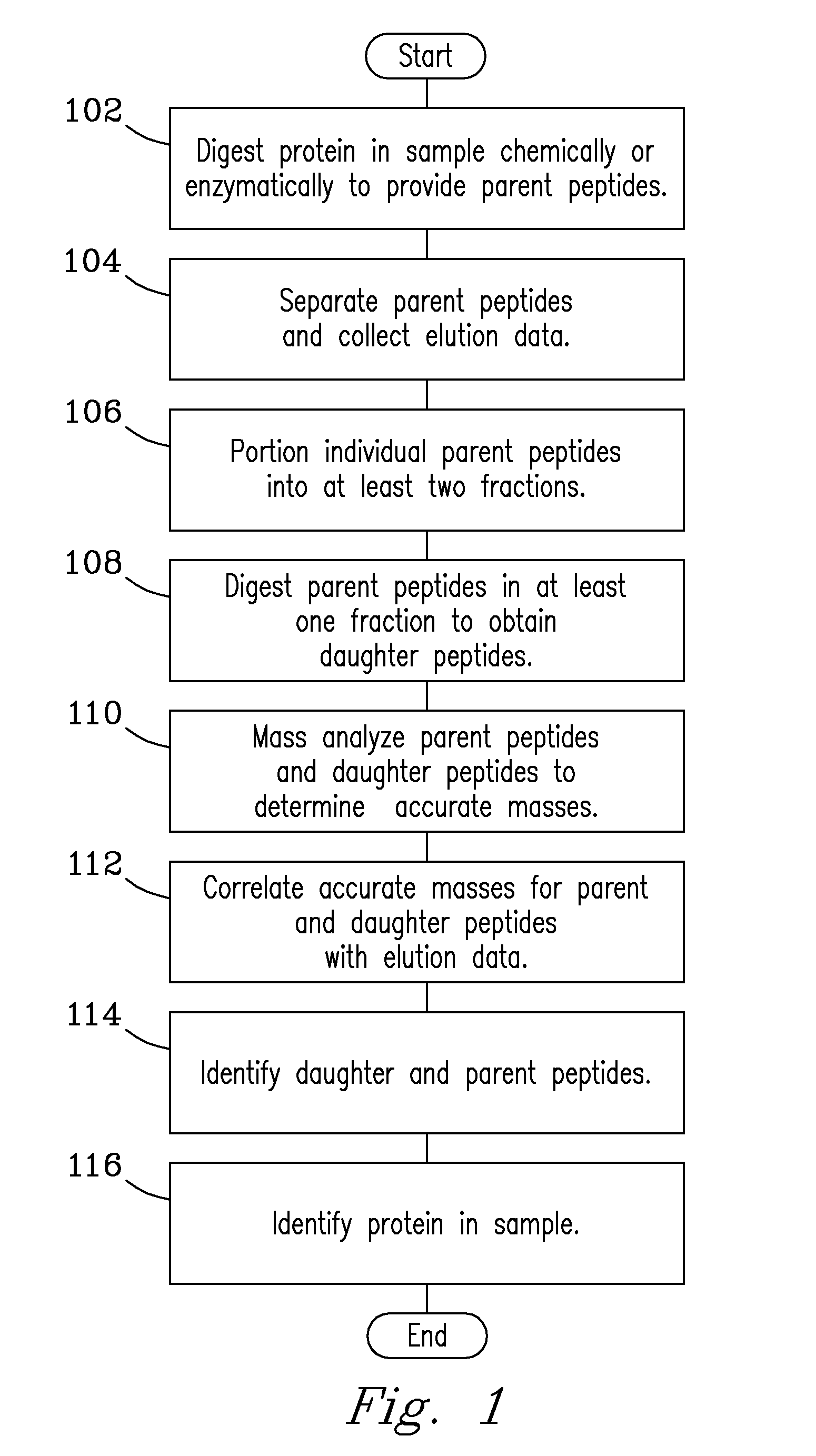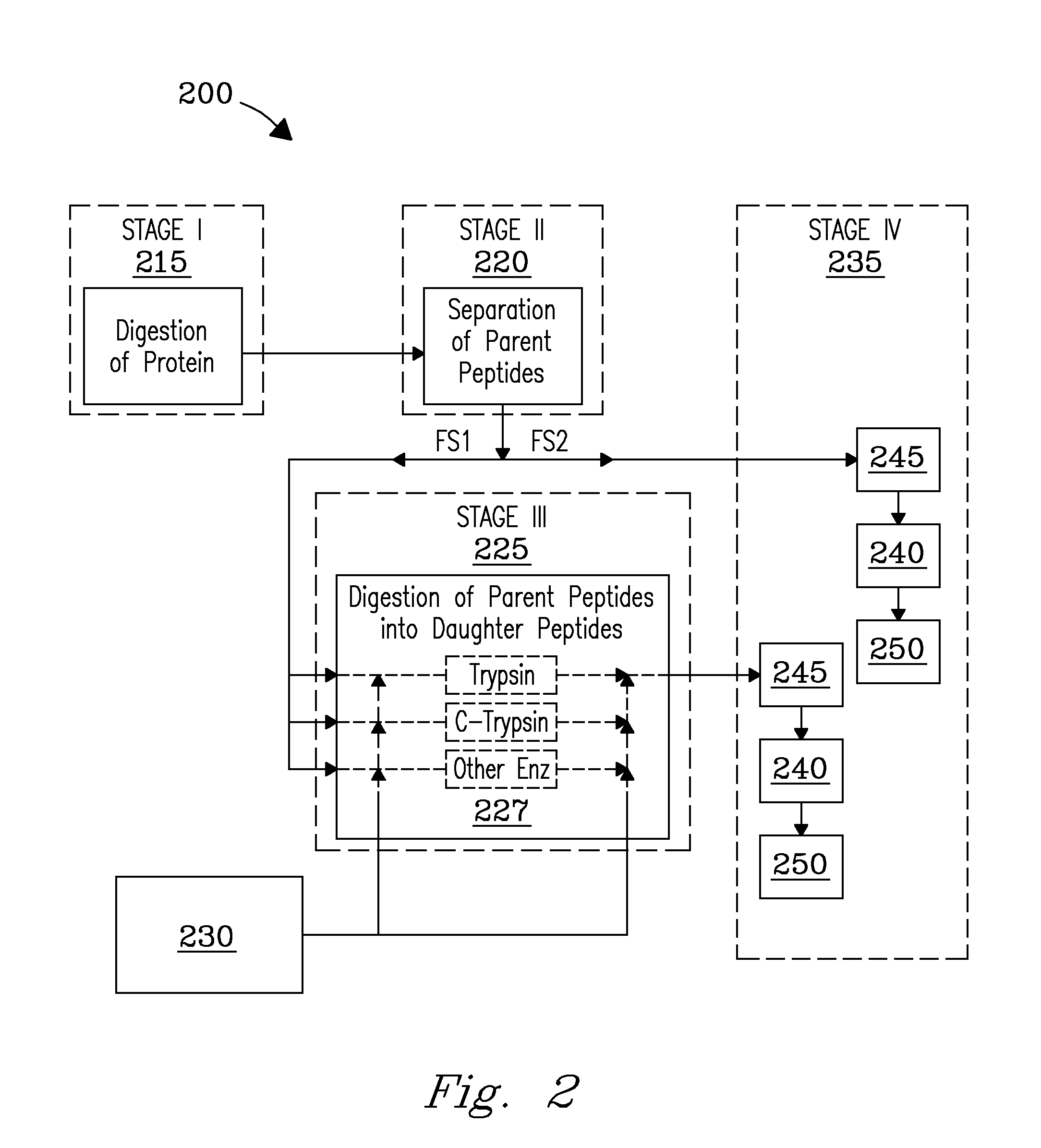[0004]The present invention includes a system for fragmentation of proteins in solution (termed “in-solution” fragmentation) that includes: a fragmentation (digestion) stage, where intact proteins and polypeptides in a sample are cleaved into parent peptides of a preselected size; a separations stage, where parent peptides are separated to obtain individual parent peptides or groups of parent peptides; at least one additional in-solution fragmentation (digestion) stage, where separated parent peptides are fragmented (digested) into daughter peptides with a size that is smaller than the parent peptides; and an analysis stage, where parent peptides and corresponding daughter peptides are analyzed for identification of the sample proteins. The present invention also includes a process for fragmenting proteins in solution that includes the steps of: fragmenting (digesting) a protein in solution or in gel to obtain parent peptides; separating the parent peptides to obtain individual parent peptides or groups of parent peptides; digesting the individual parent peptides or the groups of parent peptides at least partially in solution or in gel to obtain at least a quantity of daughter peptides. The present invention also includes a process for fragmenting proteins in solution (termed “in-solution” fragmentation) that includes the steps of: fragmenting a protein in solution or in gel to obtain parent peptides; separating the parent peptides to obtain individual parent peptides or groups of parent peptides; fragmenting (digesting) a preselected portion of individual parent peptides or groups of parent peptides in solution to obtain daughter peptides for same. The daughter peptides have a size that is smaller than the parent peptides. Daughter peptides are typically smaller in size than the parent peptides from which they are derived. At least one preselected portion or fraction of each individual parent peptides or groups of parent peptides is retained intact for subsequent analysis; and analyzing individual parent peptides, groups of parent peptides, and corresponding daughter peptides for more accurate identification of the sample proteins. Fractions containing preselected quantities of each individually separated parent peptide or group of parent peptides, and daughter peptides can be subjected to mass analysis in various ways. In one embodiment, mass analysis of each parent peptide or group of parent peptides in at least one fraction, with corresponding mass analysis of daughter peptides derived from in solution fragmentation of parent peptides in another fraction is done simultaneously (e.g., in different mass analyzers) that yields accurate mass data for both parent and daughter peptides with an identical analysis time profile. In another embodiment, mass analysis of parent and daughter peptides is done in a single analyzer in succession, e.g., in conjunction with a dual channel ion funnel. Daughter peptides, since they are derived from parent peptides following separation of the parent peptides, have elution profiles that match with the parent peptides, which provides ability to correlate accurate mass data for individual parent peptides with mass data for the corresponding daughter peptides, that provides more accurate identification of the daughter peptides, parent peptides, and proteins and polypeptides in the sample. In-solution fragmentation processes of the invention are not limited to selected proteins. Proteins in a sample can include de novo proteins. Proteins in a sample can also be synthesized in vitro. Proteins can also be in-silico proteins. Proteins in a sample can include human proteins, animal proteins, insect proteins, mammalian proteins, cellular proteins, bacterial proteins, proteins that contain nucleic acids (e.g., RNA and DNA), and other biological proteins, including combinations of the listed types. Parent peptides generated by digestion can be separated using any liquid separations process (e.g., a liquid chromatography process) or separations devices (e.g., a separations column such as a liquid chromatography separations column). Separation of parent peptides may be accomplished in online or in offline operations, using LC columns in concert with various stationary phases. Separation of peptides may also be accomplished using lab-on-a-chip and multiplate separation processes and devices; high-efficiency multidimensional separation processes and devices, microseparations processes and devices including, e.g., microfluid and microcolumn separation processes and devices; Electrophoresis, Capillary Electrophoresis (CE), Dielectrophoresis (DEP), Capillary Isoelectric Focusing, Gel separations in one or more dimensions, including, but not limited to, e.g., 2-D Gel Electrophoresis, and Sodium Dodecyl Sulfate Polyacrylamide Gel Electrophoresis (SDS-PAGE); and like separation processes or devices. Peptides may also be separated to obtain elution data and elution profiles that include, but are not limited to, e.g., molecular weight data; isoelectric point data; elution time data; retention time data; and peptide predictions for peak elution times for parent and daughter peptides; and like parameters. Preselected quantities of separated parent peptides are portioned into at least a first and second fraction (in offline operation) or analysis stream (in online operation) using a stream splitter or equivalent stream splitting means. At least one fraction containing individual parent peptides is introduced in succession to a digestion stage and digested enzymatically with enzymes including, e.g., trypsin, chymotrypsin, pepsin, and like proteases. Parent peptides are digested to obtain daughter peptides using orthogonal enzymes, i.e., different enzymes from those used in the prior digestion of proteins that yield parent peptides. In other embodiments, following post column separation, parent peptides can be digested to obtain daughter peptides in a digestion stage in one or more flow paths that contain one or more different enzymes in succession. In other embodiments, parent peptides can be digested using immobilized enzymes. Configurations are not limited. Daughter peptides provide additional structural information by which daughter and parent peptides can be identified. Daughter peptides have a molecular weight that is at or below the molecular weight of the parent peptide from which they are derived. Daughter peptides preferably have molecular weights in the range from about 300 Daltons to about 6,000 Daltons, but are not limited thereto. More preferably, daughter peptides have a molecular weight up to about 1,500 Daltons. In-solution fragmentation described herein provides for analysis of parent peptides, and / or daughter peptides without need of a fragmentation step in the gas phase of a mass analyzer. In one analysis process involving a dual mass analyzer configuration, parent peptides in a first analysis stream or fraction and daughter peptides in a second analysis stream or fraction can be concurrently analyzed, which provides accurate mass data for both parent peptides and daughter peptides with equivalent analysis times; elution profiles are also identical permitting alignment and correlation of accurate mass data and elution data for both parent and daughter peptides for identification of the peptides. In an alternate process, parent and daughter peptides can be analyzed in a single mass analyzer, e.g., serially. Analysis of at least a first and a second analysis stream in an MS analyzer can include an MS / MS analysis of at least one of the analysis streams. The apex of elution peaks for daughter peptides generated in the digestion of parent peptides substantially matches an apex of elution peaks from parent peptides generated from the digestion of sample proteins, such that daughter peptides and / or fragments can be aligned and assigned to individual parent peptides in combination with additive measures, thereby providing identification of daughter peptides and parent peptides. Additive measures include peak height, elution time, accurate mass, and combinations of the additive measures. Identification of daughter peptides and / or parent peptides and ultimately proteins in a sample includes comparing elution profiles for daughter peptides and parent peptides as a function of time with their corresponding accurate masses. Identification of protein in the sample, including daughter peptides and / or parent peptides can further include correlating additive measures for peak elution times for daughter peptides with peak elution times for corresponding parent peptides, thereby profiling same. Correlating additive measures such as peak elution times for daughter peptides and for corresponding parent peptides can be done using suitable algorithms. Predictions for peak elution times for parent peptides can be made using an artificial neural network. The artificial neural network yields probabilities for which parent peptides will be observed in the separations process. The present invention may be embodied in many different forms. For the purpose of promoting an understanding of the principles of the invention, reference will now be made to embodiments illustrated in the accompanying drawings, and specific language will be used to describe the same, in which like numerals in different figures represent the same structures or elements. It will nevertheless be understood that no limitation in scope of the invention is thereby intended. Any alterations and further modifications in the described embodiments, and any further applications of the principles of the invention as described herein are contemplated as would normally occur to one skilled in the art to which the invention relates. This abstract is neither intended to define the invention of the application, which is measured by the claims, nor is it intended to be limiting as to the scope of the invention in any way.
 Login to View More
Login to View More 


